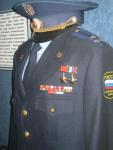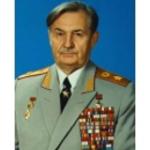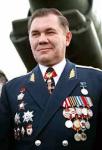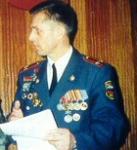-
Posts
14,343 -
Joined
-
Last visited
-
Days Won
25
Content Type
Profiles
Forums
Blogs
Gallery
Events
Store
Everything posted by Ed_Haynes
-

Soviet Soviet awards for Afghanistan
Ed_Haynes replied to Ed_Haynes's topic in Russia: Soviet Orders, Medals & Decorations
Some interesting Soviet Afghan stuff on exhibition in Copenhagen in 2005. See http://gmic.co.uk/index.php?showtopic=7393&st=11 and following posts. -

Soviet Soviet awards for Afghanistan
Ed_Haynes replied to Ed_Haynes's topic in Russia: Soviet Orders, Medals & Decorations
Fascinating photo - a jacket I want to pull back! Though he is a RUSSIAN, not SOVIET hero?! Not like this double: -

Soviet Order of Glory 3rd class.
Ed_Haynes replied to Chris Boonzaier's topic in Russia: Soviet Orders, Medals & Decorations
Absolutely, but for the type collectors the research doesn't matter. (Is that why so many dealers/collectors pitch the research out?) I am so glad I paid to get my $20 Glory to First Sergeant Alexandra V. Grebenschchikova researched! (See http://gmic.co.uk/index.php?showtopic=2329 for her award.) The research is the history that brings an inert thing to life. -

Imperial Russia 4th class St. George cross for other ranks
Ed_Haynes replied to David Gregory's topic in Russia: Imperial
So the numbering was done by only one set of hands? -

Imperial Russia 4th class St. George cross for other ranks
Ed_Haynes replied to David Gregory's topic in Russia: Imperial
Reasons, please. Such unsupported statements reek of other fora. -
Very interesting. When research becomes a possibility, maybe we'll get some answers regarding the existence of this and other such clusters "in captivity".
-
Still, I think we need to remind ourselves -- and constantly remain aware -- that there is a chronology here. Not all orders and medals were created and available at the same moment in time, different tools lay in the toolbox of honor at different times. Likewise, within the context of an abiding overall ideology (very different from that of capitalist societies), there were momentary needs that had to be served (was agricultural production going well, was the war goiung badly, etc.).
-
Probably in years of the Showa era? From the coronation of the Emperor Showa (a.k.a. Hirohito) in 1926 C.E.?
-
An interesting thread and an interesting topic. Maybe larger than we realise? A stupid (novice) question: How much of out glib division of "military" vs. "civil" awards is, in fact, just fixating on a late GPW pattern? Obviously, things like Lenin, Red Star, and even GPW could, for a while, be awarded, freely and seamlessly, to comrades in uniform and those in labor (reflecting the unity of soldiers and workers and all that). Maybe the division that we (in the West) like (so much, too much?) to make didn't come along until late in (or after?) the GPW? Obviously, the Red Banner was the exception, but it had two divisions to reflect this double nature, military and labor, and it always had, from the beginning of the new Soviet honors system. Only with the creation of the HSL was there an implicit division even within the "hero" stratosphere. Am I just indulging in a late-Sunday afternoon fantasy or . . . ???
-

Soviet Order of Glory 3rd class.
Ed_Haynes replied to Chris Boonzaier's topic in Russia: Soviet Orders, Medals & Decorations
Yes, it is all about the reaserch. But we knew that already, eh? -

Soviet Order of Glory 3rd class.
Ed_Haynes replied to Chris Boonzaier's topic in Russia: Soviet Orders, Medals & Decorations
Checking the two dealers whose websites are at the head of my favorites list, I see prices for single, undocumented, unresearched Glory 3s ranging from $45 to $115. And $45-$50 sounds about right to me. -

Soviet Soviet awards for Afghanistan
Ed_Haynes replied to Ed_Haynes's topic in Russia: Soviet Orders, Medals & Decorations
I have the book, though it being in Russian it isn't of much use to me. If the book says this, then it is speaking rubbish (too). -
Wow! Nice photos. Many thanks for posting! You should get the captions translated.
-

Soviet Soviet awards for Afghanistan
Ed_Haynes replied to Ed_Haynes's topic in Russia: Soviet Orders, Medals & Decorations
Blue and white is the correct ribbon for this medal (what I show); Igor's image is WRONG. Medal wholesalers in Kabul do a massive free-wheeling job of mix-and-match of medals and ribbons and dealers sell whatever they get. The Glory you show is on the ribbon of the long service medal (in one of its immensely coinfusing incarnations). See my "Afghan Abyss" for more than you ever wanted to know. -

Soviet Soviet awards for Afghanistan
Ed_Haynes replied to Ed_Haynes's topic in Russia: Soviet Orders, Medals & Decorations
That is it, though on the wrong ribbon! (Herewith, an old scan, was going to do a better scan for my "Afghan Abyss" thread when I get the boys on home leave -- http://gmic.co.uk/index.php?showtopic=12313 ). -

My New WW2 Commonwealth Stars
Ed_Haynes replied to Avitas's topic in Great Britain: Orders, Gallantry, Campaign Medals
Such abominations are common. When the medal is not sparkly enough, it gets "improved". Sometimes by individual personal aesthetics, sometimes the colonel just likes shiny things (colonels being easily amused by shiny moving objects). In WWI, it was fairly common for Indian soldiers to have their stars and victory medals silver plated or dipped or just painted, as bronze medals were seen as awards for "followers" only. -

Soviet Soviet awards for Afghanistan
Ed_Haynes replied to Ed_Haynes's topic in Russia: Soviet Orders, Medals & Decorations
-

Soviet Soviet awards for Afghanistan
Ed_Haynes replied to Ed_Haynes's topic in Russia: Soviet Orders, Medals & Decorations
And, if you have the right fonts and the right language skills (I don't), see: http://www.afghanwar.spb.ru/ -

Soviet Soviet awards for Afghanistan
Ed_Haynes replied to Ed_Haynes's topic in Russia: Soviet Orders, Medals & Decorations
On our interesting Colonel Shubin, see: http://www.specialoperations.com/mout/soviet5.html -

Soviet Soviet awards for Afghanistan
Ed_Haynes replied to Ed_Haynes's topic in Russia: Soviet Orders, Medals & Decorations
A teeny image (expanded a bit) of Varennikov. See also: http://informacia.ru/facts/varennikov-facts.htm -

Soviet Order of Glory 3rd class
Ed_Haynes replied to Alfred's topic in Russia: Soviet Orders, Medals & Decorations
I will agree that researching military awards is much easier than civil awards, and if that were (as I think it is in Dave's case) the sole reason for a pro-military awards bias, I could (and do) understand it completely. Some limited, sporadic, research is possible on (some) labor awards, but it is largely newspaper-based at present, and follows much more a "who is/was this person" approach. This is much more difficult research task than pulling service records and decoration recommendations (not to belittle that as a research task, though!). Maybe, someday, records will be available for labor research with the same ease and the same depth that military awards now enjoy. Maybe, maybe not. I still throw out the question: Which was or greater relevance to the success of the Soviet Union, being the random first man to cross some river in central Poland or working for decades to increase food production to feed the people? Maybe one makes a sexier, more cinematic story, one that resonates for those who are themselves military veterans and never worked on a farm, but which was more important? And, moreover, which tells us more about the values and nature of Soviet State and society? -

Soviet Soviet awards for Afghanistan
Ed_Haynes replied to Ed_Haynes's topic in Russia: Soviet Orders, Medals & Decorations
-

Soviet Soviet awards for Afghanistan
Ed_Haynes replied to Ed_Haynes's topic in Russia: Soviet Orders, Medals & Decorations








